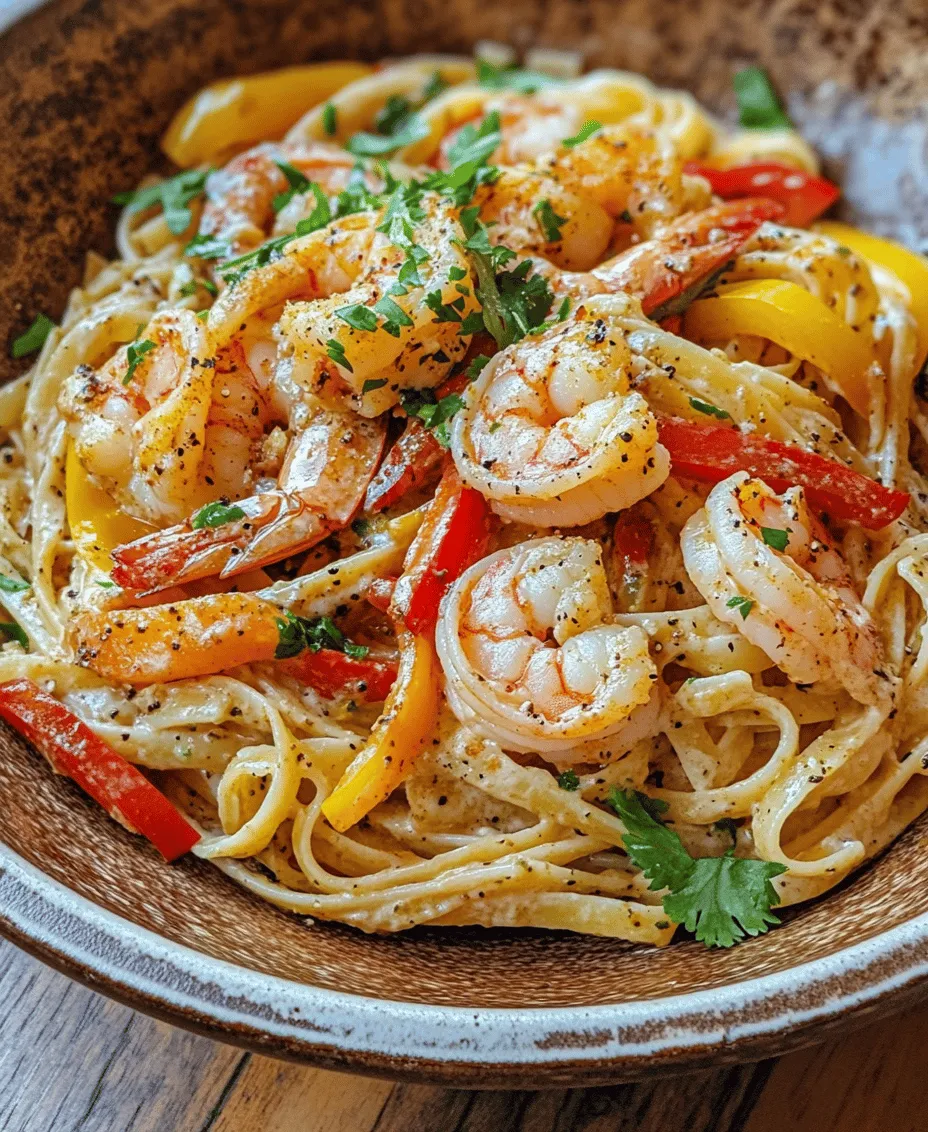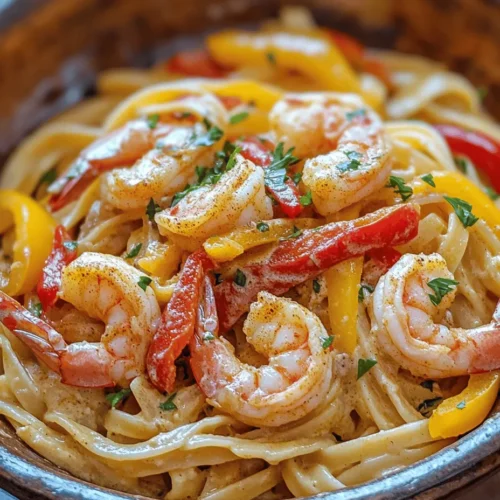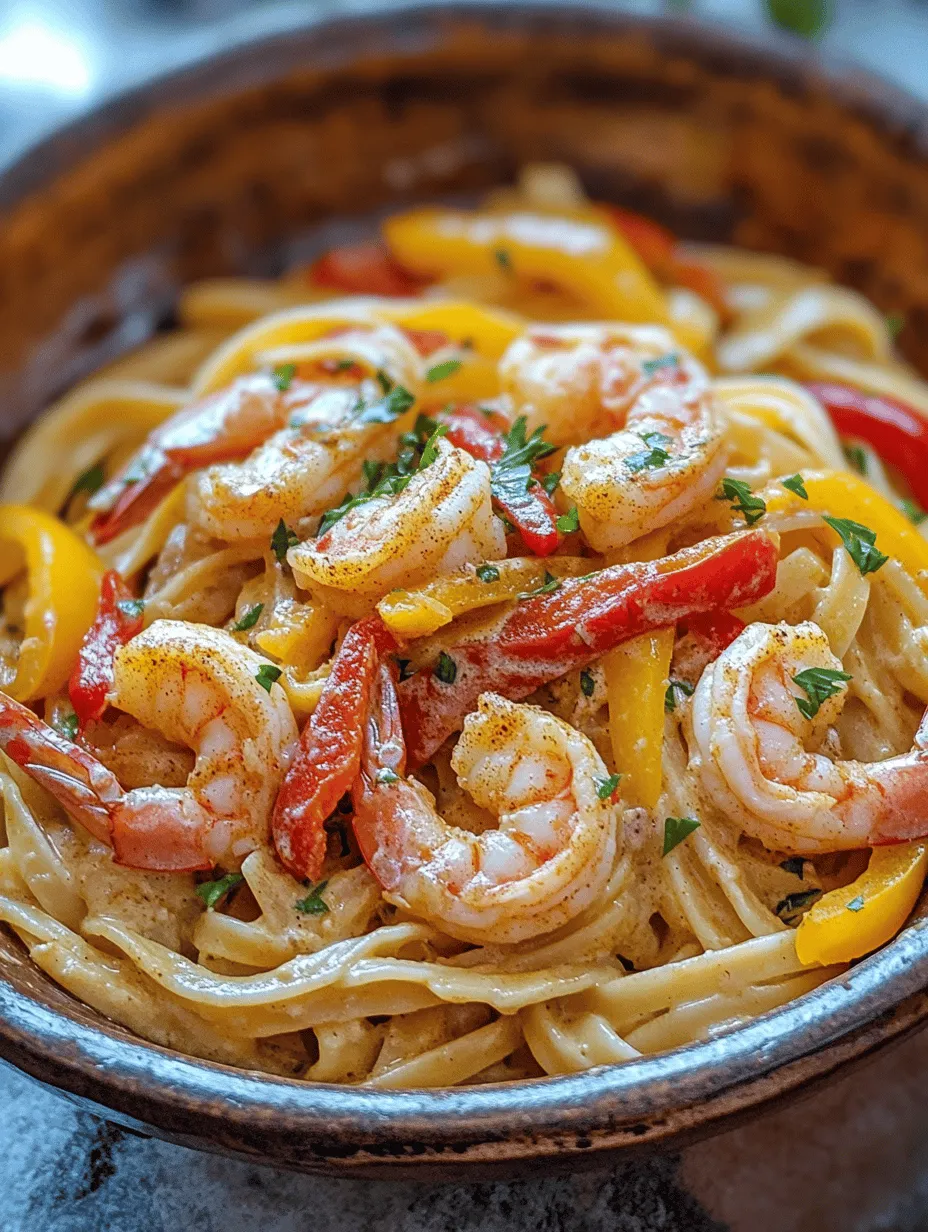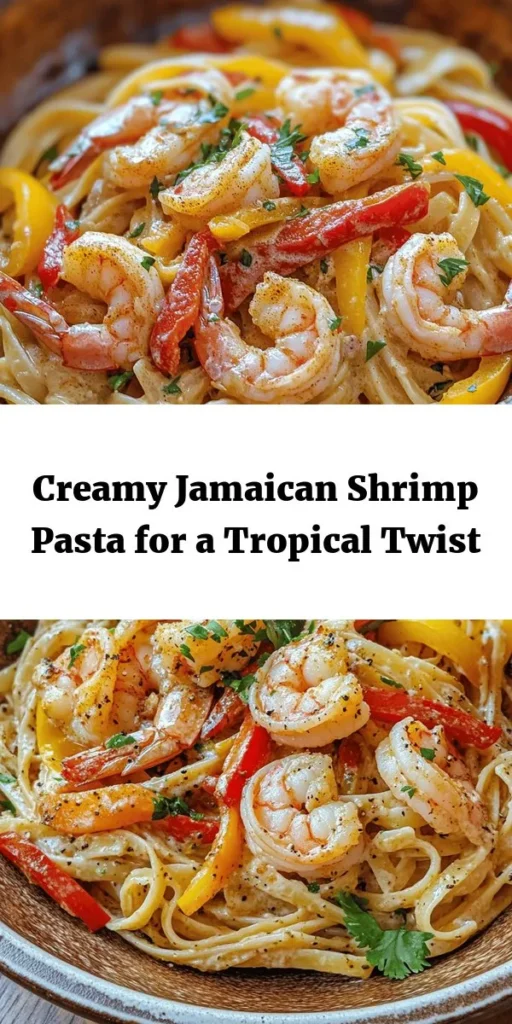Introduction
Jamaican cuisine is a vibrant tapestry of flavors and aromas, deeply rooted in the island’s rich cultural heritage. It is a delicious blend of African, European, and indigenous influences, characterized by its bold spices, fresh ingredients, and hearty preparations. Among the standout features of Jamaican cooking are its diverse spice blends, particularly the famous jerk seasoning, which infuses dishes with a unique heat and complexity.
In this article, we will explore an exciting fusion dish that beautifully marries Caribbean flavors with Italian culinary techniques: Jamaican Shrimp Pasta. This delightful recipe showcases succulent shrimp tossed in a creamy sauce that is elevated by the vibrant notes of jerk seasoning, resulting in a dish that is both comforting and exotic. With its rich texture, bold flavors, and quick preparation time, Jamaican Shrimp Pasta is perfect for busy weeknights or special occasions when you want to impress your guests with something unique.
Understanding Jamaican Cuisine
To fully appreciate Jamaican Shrimp Pasta, it’s essential to understand the key components of Jamaican cuisine. The island’s culinary landscape is rich with fresh produce, seafood, and aromatic spices, making it a paradise for food lovers. Some of the most common ingredients found in Jamaican dishes include:
– Fresh seafood: Given Jamaica’s coastal location, seafood plays a significant role in the local cuisine. Fish, shrimp, and lobster are often featured in various preparations, showcasing the island’s abundant marine resources.
– Spices and herbs: Jamaican cooking is renowned for its use of bold spices. Jerk seasoning, a staple in Jamaican kitchens, is a particular highlight. This spice blend typically contains allspice, thyme, scallions, cinnamon, nutmeg, and Scotch bonnet peppers, lending a distinctive heat and flavor to dishes.
– Fruits and vegetables: The island’s tropical climate allows for a wide variety of fruits and vegetables, such as plantains, ackee, yams, and bell peppers, which are frequently incorporated into meals to enhance flavor and nutrition.
Culturally, shrimp holds a significant place in Caribbean cuisine. It is not only a popular ingredient but also a symbol of the region’s culinary abundance. Shrimp can be found in countless dishes, from traditional stews to grilled preparations, showcasing its versatility and appeal.
Ingredients Breakdown
To create a mouthwatering Jamaican Shrimp Pasta, we need to gather a selection of high-quality ingredients that will contribute to the dish’s creamy texture and bold flavors. Below is a detailed breakdown of each ingredient used in the recipe:
– Pasta (Linguine or Fettuccine): Selecting the right pasta is crucial for achieving a creamy sauce that clings to each strand. Linguine, with its flat surface, or fettuccine, known for its wider noodles, are both excellent choices for this dish. Their shapes allow them to hold onto the rich sauce, ensuring each bite is flavorful and satisfying.
– Shrimp: The star ingredient of this dish is, of course, shrimp. Opting for fresh or high-quality shrimp is essential for the best results. Fresh shrimp, preferably wild-caught, will have a firm texture and a sweet, briny flavor that complements the creamy sauce perfectly. If fresh shrimp is not available, frozen shrimp can be used; just ensure they are properly thawed before cooking.
– Olive Oil: This versatile oil not only serves as a cooking medium but also adds a subtle flavor to the dish. Extra virgin olive oil is preferred for its rich taste and health benefits, including heart-healthy fats and antioxidants.
– Vegetables: Onions, garlic, and bell peppers are commonly used in this recipe to enhance the overall flavor profile. Onions provide sweetness, garlic adds depth, and bell peppers introduce a hint of brightness. Together, they create a flavorful base for the sauce.
– Coconut Milk and Heavy Cream: To achieve the desired creaminess in the sauce, coconut milk and heavy cream are combined. Coconut milk contributes a subtle sweetness and a tropical essence, while heavy cream adds richness and a velvety texture. The combination results in a sauce that is both indulgent and satisfying.
– Jerk Seasoning: As a defining element of Jamaican cuisine, jerk seasoning infuses the shrimp with its signature flavor profile. The blend of spices offers a complex taste experience, from aromatic to spicy, making it an ideal complement to the creamy sauce. There are various kinds of jerk seasoning available, including mild and spicy versions, allowing you to customize the heat level to your preference.
– Lime Juice and Cilantro: A splash of lime juice adds a refreshing acidity that balances the richness of the sauce, while fresh cilantro brings a burst of herbaceous flavor. These ingredients help to elevate the dish and brighten the overall taste.
– Optional Garnishes: For those who want to take their Jamaican Shrimp Pasta to the next level, a sprinkle of freshly grated Parmesan cheese can add a delightful umami flavor. While not traditional in Jamaican cuisine, it can complement the creamy sauce beautifully.
Step-by-Step Cooking Instructions
Now that we have all our ingredients ready, let’s dive into the step-by-step instructions for preparing Jamaican Shrimp Pasta. The process is straightforward, making it an excellent option for both novice cooks and seasoned chefs alike.
1. Cook the Pasta: Start by boiling a large pot of salted water. Once it reaches a rolling boil, add your choice of linguine or fettuccine. Cook according to the package instructions until al dente. Once cooked, reserve a cup of pasta water for later use, then drain the rest and set the pasta aside.
2. Prepare the Shrimp: While the pasta is cooking, rinse the shrimp under cold water and pat them dry with paper towels. If you are using whole shrimp, be sure to devein and remove the shells. Season the shrimp generously with jerk seasoning, ensuring they are evenly coated for maximum flavor.
3. Sauté the Vegetables: In a large skillet, heat a tablespoon of olive oil over medium heat. Add chopped onions and bell peppers, sautéing until they begin to soften, about 3-4 minutes. Add minced garlic and cook for an additional minute, until fragrant.
4. Cook the Shrimp: Push the sautéed vegetables to the side of the skillet and add the seasoned shrimp. Cook for 2-3 minutes on each side, or until they turn pink and opaque. Avoid overcrowding the pan; you may need to cook in batches if you have a lot of shrimp.
5. Create the Sauce: Once the shrimp are cooked, lower the heat and pour in the coconut milk and heavy cream. Stir to combine, and let the mixture simmer for a couple of minutes, allowing it to thicken slightly. If the sauce appears too thick, you can add some reserved pasta water until the desired consistency is achieved.
6. Combine the Pasta: Add the cooked pasta to the skillet, tossing it gently to coat in the creamy sauce. Incorporate lime juice and chopped cilantro at this stage, adjusting seasoning with salt and pepper to taste.
7. Serve: Once everything is well combined, serve the Jamaican Shrimp Pasta hot, garnished with additional cilantro and a sprinkle of Parmesan cheese if desired.
This step-by-step guide lays the foundation for a delicious Jamaican Shrimp Pasta that will delight your taste buds with its creamy texture and bold flavors. In the next part of this article, we will delve deeper into tips for achieving the best results and address common questions to ensure your cooking experience is seamless and enjoyable.

Detailed Cooking Process
Cooking Pasta to Perfection
To begin with, the pasta serves as the foundation for our Jamaican Shrimp Pasta. Selecting the right pasta type is crucial; fettuccine or linguine are excellent choices due to their ability to hold onto the creamy sauce. Here’s how to cook it perfectly:
1. Boil Water: Fill a large pot with water, allowing for at least 4 quarts per pound of pasta. This ensures that the pasta cooks evenly and does not stick together.
2. Salt the Water: Once the water reaches a rolling boil, add a generous amount of salt (about 1-2 tablespoons). This enhances the pasta’s flavor from the inside out.
3. Add the Pasta: Drop the pasta into the boiling water. Stir immediately to prevent sticking.
4. Cook Al Dente: Refer to the package instructions for cooking time but aim for al dente, which means the pasta should be tender yet firm to the bite. This usually takes about 8-12 minutes.
5. Reserve Pasta Water: Before draining, reserve a cup of the starchy pasta water. This will be useful later to adjust the sauce consistency.
6. Drain and Toss: Drain the pasta in a colander but do not rinse it, as the starch helps the sauce cling to it. Toss the pasta lightly with a drizzle of olive oil to prevent it from sticking while you prepare the sauce.
Properly Sautéing Shrimp for Maximum Flavor and Texture
The shrimp is the star of this dish, and how you cook it can significantly impact the overall flavor and texture. Here’s how to achieve perfectly sautéed shrimp:
1. Prep the Shrimp: If using raw shrimp, ensure they are peeled and deveined. Pat them dry with paper towels to remove excess moisture, which can prevent proper searing.
2. Season Generously: In a bowl, season the shrimp with salt, pepper, and a pinch of paprika or cayenne pepper for that signature Jamaican kick. Marinate them for about 15 minutes to absorb the flavors.
3. Heat the Pan: Use a large skillet over medium-high heat. Add a tablespoon of olive oil along with a pat of butter for richness. Wait until the oil shimmers and the butter is fully melted.
4. Sauté the Shrimp: Carefully add the shrimp in a single layer, ensuring not to overcrowd the pan. Sauté for about 2-3 minutes on each side until they turn pink and slightly caramelized. Overcooking shrimp can lead to a rubbery texture, so watch closely!
5. Remove and Set Aside: Once cooked, remove the shrimp from the skillet and set aside while you prepare the sauce. This prevents them from cooking further.
Creating a Creamy Sauce: Tips for Achieving the Right Consistency
The creamy sauce is what makes this dish truly delightful. Follow these key steps to create a sauce that is rich and velvety:
1. Sauté Aromatics: In the same skillet used for the shrimp, add a bit more butter if necessary. Sauté minced garlic and diced onions over medium heat until fragrant and translucent, about 2-3 minutes. You can also add diced bell peppers at this stage for added flavor and color.
2. Deglaze the Pan: Pour in a splash of white wine or chicken broth, scraping up any brown bits from the bottom of the pan. This adds depth to your sauce.
3. Add Cream: Slowly pour in heavy cream, stirring to combine. The cream should be added gradually to control the thickness.
4. Seasoning: Stir in the Jamaican jerk seasoning, fresh lime juice, and a pinch of nutmeg. Taste and adjust the seasoning with salt and pepper. If the sauce seems too thick, add a bit of the reserved pasta water until you reach the desired consistency.
5. Incorporate Cheese: For a cheesy finish, mix in grated Parmesan cheese, stirring until melted and fully incorporated into the sauce.
Combining All Elements: Ensuring a Harmonious Blend of Flavors
Now that all components are prepared, it’s time to bring the dish together:
1. Combine Pasta and Sauce: Add the cooked pasta to the skillet with the creamy sauce. Toss to coat the pasta evenly. If the sauce is too thick, add a little more of the reserved pasta water.
2. Return the Shrimp: Gently fold in the sautéed shrimp, ensuring they are well-distributed throughout the pasta.
3. Final Touches: Sprinkle with freshly chopped parsley or cilantro for a burst of freshness and color. Serve immediately for the best texture and flavor.
Flavor Profile and Texture
The flavor profile of Jamaican Shrimp Pasta is a delightful combination of sweet, spicy, and creamy notes. The jerk seasoning brings a robust spicy kick balanced by the sweetness of the shrimp and the creaminess of the sauce. Here’s a closer look at the key elements:
– Sweetness: The natural sweetness of the shrimp paired with the creaminess of the sauce offers a nice contrast to the spice.
– Spiciness: The jerk seasoning introduces heat, which can be adjusted to suit personal preferences. For those who prefer milder flavors, consider reducing the amount of seasoning or using a less spicy variant.
– Creaminess: The heavy cream and cheese create a luscious sauce that envelops each bite, making the dish feel indulgent without being overwhelming.
Texture Contrast
The dish’s texture is equally inviting, boasting a satisfying contrast:
– Tender Pasta: The al dente pasta provides a perfect base, offering a slight bite that complements the creamy sauce.
– Succulent Shrimp: The shrimp should be juicy and tender, providing a delightful pop with each bite.
– Crisp Vegetables: Any added vegetables, such as bell peppers or green onions, offer a refreshing crunch that elevates the overall dish.
Serving Suggestions
To elevate your Jamaican Shrimp Pasta experience, consider these serving suggestions:
– Ideal Pairings: This dish pairs wonderfully with a fresh side salad, featuring mixed greens, cherry tomatoes, and a light vinaigrette. You could also serve it alongside garlic bread or a light vegetable stir-fry for a complete meal.
– Presentation Tips: For an appealing presentation, serve the pasta in shallow bowls and garnish with additional parsley or lime wedges. A sprinkle of red pepper flakes can add a pop of color and a hint of heat.
– Portion Sizes: This recipe comfortably serves four, but portion sizes can be adjusted based on appetite. Consider serving smaller portions as part of a multi-course meal.
Nutritional Information
This dish not only tantalizes the taste buds but also offers nutritional benefits:
– Shrimp: A great source of lean protein, low in calories, and packed with essential nutrients like vitamin B12 and selenium.
– Pasta: Depending on the type you choose, pasta can provide complex carbohydrates, which are a great energy source.
– Cream and Cheese: While these ingredients add richness, they also contribute calcium and fat. Consider using lighter versions or alternative dairy products for a healthier option.
– Vegetables: Any additional vegetables you add will enhance the nutritional value, providing vitamins, minerals, and fiber.
For those needing dietary considerations, gluten-free pasta options are widely available and can be used as a substitute without sacrificing flavor or texture.
Conclusion
Jamaican Shrimp Pasta is more than just a meal; it’s an experience that combines the vibrant flavors of the Caribbean with the comfort of creamy pasta. This dish is perfect for special occasions or a cozy weeknight dinner, bringing a unique flair to your dining table.
Feel free to experiment with the recipe, adjusting the spice levels or swapping in your favorite vegetables to make it your own. The joy of cooking lies in creativity and sharing meals with loved ones, so gather your friends or family, and enjoy this delightful dish together. Embrace the flavors, savor every bite, and let the spirit of Jamaican cuisine inspire your culinary adventures.



